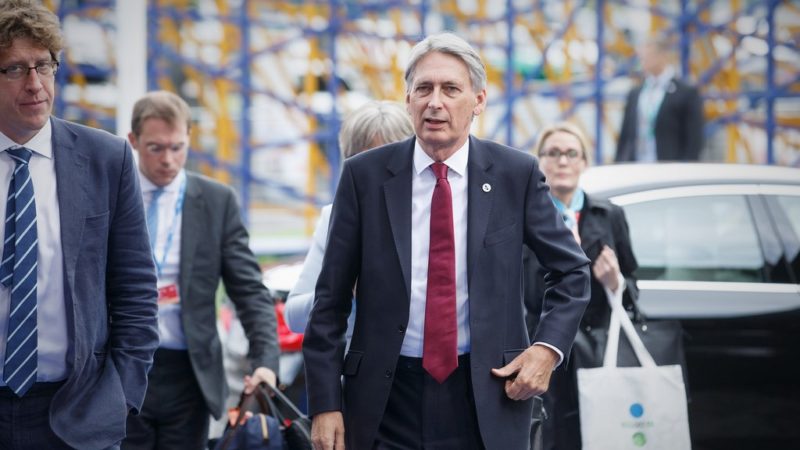Chancellor Philip Hammond will present his autumn budget in two weeks. His number one focus must be investing in a sustainable economy, argues Prem Sikka.

In the face of Brexit uncertainties, many businesses are withholding investment. But to meet the challenge, the government will need to abandon almost of its headline polices.
Austerity has become an article of faith for the government, even though such a policy was never sustainable. Austerity has not helped to reduce public debt, which has ballooned to £1,781.9bn compared to £934.9bn in August 2010. Somewhat belatedly, the government is realising the folly of the policy and the obsession with debt reduction is being constrained, at least for the time being.
Historically, the private sector has shown little appetite for long-term risks. Therefore, the state had to invest heavily into biotechnology, telecommunications, postal, information technology, utilities, shipping, railways, airlines and many other long-term industries.
For the last 40 years, the government ideology has been to privatise almost everything in sight. Instead of directly investing in the economy, the government has relied on a variety of tax incentives to persuade the private sector to invest. The results have not been encouraging.
The investment slump
The scale of failure is reflected in the difference between the UK and other European countries. On average, in 2017, EU countries put 20.1% of their GDP into long-term investment. The Czech Republic (25.2%), Sweden (24.9%), Estonia (23.7%), Austria (23.5%), Ireland (23.4%), Belgium (23.3%), Romania and Finland (both 22.6%) as well as France (22.4%) all had investment rates of over 20% of GDP.
At the opposite end of the scale, the lowest ratio of investment to GDP was recorded by Greece (12.6%), followed by Portugal (16.2%) and the United Kingdom (16.9%). These figures can’t be changed without active involvement of the state in providing social infrastructure, transport, house-building, green industries, artificial intelligence, space and other industries.
It is the same story on research and development (R&D) expenditure, a crucial element for revival of the manufacturing sector. Since the 1990s, the UK R&D expenditure has fluctuated between 1.53% and 1.67% of GDP. This is well below the EU average and below the expenditure by countries such as Sweden, Austria, Germany, France, Finland and Netherlands.
One reason for the low UK expenditure is that successive governments made a deliberate decision to prioritise the service sector. A diversified economy is always helpful and it is always a matter of balance. And it is the manufacturing sector which generally generates more skilled, semi-skilled and higher paid jobs.
Its multiplier effect – the ability to generate additional jobs – is also greater as the items need to delivered, maintained and repaired. Yet the manufacturing sector has continued to shrink and now accounts for around 9% of the UK GDP compared to 30% of in China, 20% in Germany, 12% in the US, 19% in Japan.
A squeeze on workers
The inevitable consequence of low investment in innovation, productive assets and staff reskilling is low productivity. The government statistics show that compared with the rest of the G7, the UK productivity is about 16% below the average for the rest of the G7 advanced economies. Again, the state will have a take a lead as leaving it to the private sector has not delivered the required investment or productivity.
Investment, innovation and R&D need to be accompanied by sustainable demand. Without adequate purchasing power, people cannot afford to buy goods and services and that itself discourages investment. Since 2010, the government has been wedded to austerity and building a low-wage economy. Workers’ share of the GDP for the second quarter of 2018 stands at 49.3% of GDP, compared to 65.1% in 1976.
At the same time, the increases in gas, water, electricity, rents and travel costs have further eroded people’s purchasing power. The inevitable consequence of squeeze on household budgets has been the closure of shops such as Carpetright, Jamie’s Italian, Maplin, Marks & Spencer, Mothercare, Poundworld, Prezzo and Toys R Us, just to mention a few. And city centres have become economic deserts.
What the Chancellor must do
The Chancellor needs to find ways of boosting people’s purchasing power. This could be done by curbs on profiteering by utilities and train companies, raising the minimum wage and state pension, ending gender discrimination and pay rise for women and public sector workers, abolition of university fees, and ensuring that the tax-free personal allowances for income tax purposes match the minimum wage.
There is an urgent need for investment and an equal distribution of wealth, to which neoliberals will no doubt respond with the usual comment ‘we can’t afford it.’
But can we afford stagnation, economic decline, social conflict and instability? The answer is a clear no. A government which can bailout banks with billions of quantitative easing, appease corporations and wealthy elites with tax cuts and guarantees profits through the Private Finance Initiative (PFI) and subsidies to film companies, can also find resources for economic welfare. If it chooses not to, it should make way for someone who can.
Prem Sikka is Professor of Accounting at University of Sheffield and Emeritus Professor of Accounting at University of Essex. He tweets here.
To reach hundreds of thousands of new readers and to make the biggest impact we can in the next general election, we need to grow our donor base substantially.
That's why in 2024, we are seeking to generate 150 additional regular donors to support Left Foot Forward's work.
We still need another 124 people to donate to hit the target. You can help. Donate today.



